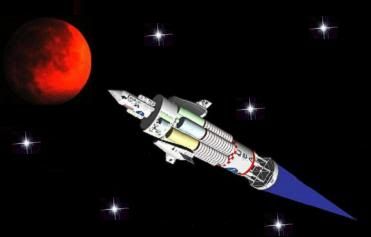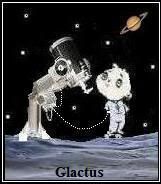Post by glactus on Oct 4, 2011 0:49:48 GMT
If you ask whether we will travel to the stars, the answer is probably yes, but it will take a long time. Maybe 500 years. If you ask whether any human being will travel to the stars within the 21st century, the answer is certainly no.To scoot around the solar system and return within a few years, you need a spacecraft that will cruise at 100 miles a second. At that speed you will get to Mars in 10 days, to Pluto in 16 months.

A Neutron spacecraft of the future
We can imagine a spacecraft carrying a big area of thin film to collect solar energy, with an ion-jet engine to produce thrust powerful enough to boost a spacecraft to a speed of 100 miles a second. It is also possible to build a nuclear-powered jet to do the same job, if the political objections to nuclear spacecraft can be overcome. The quantity of energy available from sunlight or from a nuclear reactor is large enough to take us on trips around our solar system, if we decided to spend the money to do it.

Deep into the void
We may not decide to build a 100-mile-a-second spacecraft within 100 years, but we know that it is technically possible. The cost of developing a 100-mile-a-second spacecraft would be large but not absurd. On the other hand, the nearest star is about 10,000 times as far away as Pluto.

A Nuclear craft to distant worlds
A trip to the stars within a human lifetime requires a spacecraft that cruises at more than 10,000 miles a second and accelerates to this speed within 10 years. The engine would have to deliver about a megawatt of power for every pound of weight of the ship. There is no way an engine that small and that powerful could keep itself cool. Even if the fuel is something exotic like antimatter, carrying far more energy than sunlight or uranium, the problem of cooling the engine remains insuperable. Travel to the stars within this century, using any kind of engine we know how to build, is not going to happen.
Unmanned space probes going to the stars? Unmanned probes can be much smaller and lighter than manned spaceships. That means the total power required for a probe to reach the stars is much less. But the unmanned probe still needs an engine delivering one megawatt per pound. The problem of cooling the engine remains the same, whether the ship is manned or unmanned, and the conclusion is the same. Unmanned probes are not going to reach the stars within this century.
To see video of our journey to the stars just click on the link below. Has sound.
www.youtube.com/watch?v=mpI8-DmWQqc&feature=related

Credits: These are non copywrite images
Text by Wikipedia
Video by Youtube
Space art by Glactus

A Neutron spacecraft of the future
We can imagine a spacecraft carrying a big area of thin film to collect solar energy, with an ion-jet engine to produce thrust powerful enough to boost a spacecraft to a speed of 100 miles a second. It is also possible to build a nuclear-powered jet to do the same job, if the political objections to nuclear spacecraft can be overcome. The quantity of energy available from sunlight or from a nuclear reactor is large enough to take us on trips around our solar system, if we decided to spend the money to do it.

Deep into the void
We may not decide to build a 100-mile-a-second spacecraft within 100 years, but we know that it is technically possible. The cost of developing a 100-mile-a-second spacecraft would be large but not absurd. On the other hand, the nearest star is about 10,000 times as far away as Pluto.

A Nuclear craft to distant worlds
A trip to the stars within a human lifetime requires a spacecraft that cruises at more than 10,000 miles a second and accelerates to this speed within 10 years. The engine would have to deliver about a megawatt of power for every pound of weight of the ship. There is no way an engine that small and that powerful could keep itself cool. Even if the fuel is something exotic like antimatter, carrying far more energy than sunlight or uranium, the problem of cooling the engine remains insuperable. Travel to the stars within this century, using any kind of engine we know how to build, is not going to happen.
Unmanned space probes going to the stars? Unmanned probes can be much smaller and lighter than manned spaceships. That means the total power required for a probe to reach the stars is much less. But the unmanned probe still needs an engine delivering one megawatt per pound. The problem of cooling the engine remains the same, whether the ship is manned or unmanned, and the conclusion is the same. Unmanned probes are not going to reach the stars within this century.
To see video of our journey to the stars just click on the link below. Has sound.
www.youtube.com/watch?v=mpI8-DmWQqc&feature=related
Credits: These are non copywrite images
Text by Wikipedia
Video by Youtube
Space art by Glactus


